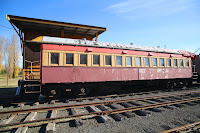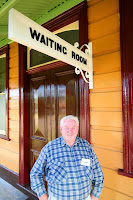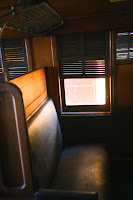I was one of the display exhibits and was at the HARS airshow for my 5th time since 2008. The HARS airshow is nowadays one of the few shows in NSW which i attend, due to it been relatively close to Sydney. (On a interesting side note….not too long ago Sydney used to have a few regular airshows but over the last 10-20yrs, sadly for the aviation community in Australia, many of the local airshows and sadly airports as well have been closed down/growing lack of interest in sustaining aviation in Sydney and people nowadays travel to the country or coastal areas where the airshows are run with passion and welcoming open arms. With this change regional, Sydney loses out and regional NSW gains the economic benefits which Sydney once had. Regional jobs are supported as regional town caters for the airshow demands).
Below is an overview of my display area showing the general setup i use.
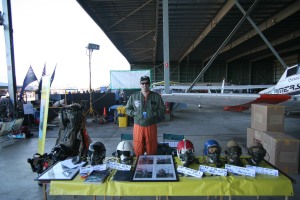

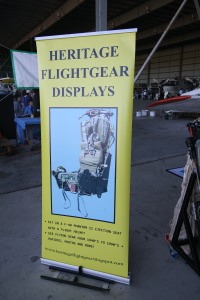


The interest in the flightgear display at the HARS airshow has grown over the last few years and quite a few people are quite keen to see my display each year which is growing in size and items i put on show.
FLIGHT HELMETS ON DISPLAY
A close up of the 1940-1990s era flight helmets i had on show. I brought along a small selection but a wide variety of flightgear to educate the public with. The display was set up to show USAAF ANH-15 WW2 era, RAAF E type Korean War era, USAF P-1A Korean War era , USAF HGU-2A/P Vietnam war, US Army helicopter APH-5 Vietnam War era and USAF HGU-55/P current/modern era.
I also have on display a few photos of the flightgear reenactments i have held over the years, by been part of the Australian Warbirds Association Limited (AWAL) where i work with warbird owners around Australia to showcase warbird heritage. These events allow me to have a warbird aircraft on show with myself dressed in the correct aircraft and era flightgear. Some examples of the eras i cover include RAAF Korean War, USAF Vietnam War etc. These photos enable visitors to see what pilots wore in 1940-70s and to gain an understanding just how complex flightgear can be.




F-4 PHANTOM EJECTION SEAT ON DISPLAY
The ex USAF F-4 Phantom Martin Baker H7 ejection seat from a USAF F-4D Phantom is my main display drawcard attraction at the moment. It is the only regular and publicly displayed F-4 Phantom ejection seat in Australia and as such gains a lot of interest from kids and adults asking about the seat, what it was used in and how it was used.
The seat cost over $7,000 ($ Aus) to restore over 2years from 2010-2011. It is nearly completed except for a few pyrotechnic functions, main parachute ( for the moment absent) and main beam parts. All these parts aren’t really necessary for a static display i feel as they add totally unnecessary weight to the transportation of the seat. The seat already weighs in around 180kg at present.
Educating kids to be safety aware on an ejection seat and not pull or touch the black and yellow ejection handles is a difficult task, as they are so keen to touch and fiddle with the display. I have built some safeguards into the seat to limit any potential damage to my asset.


I am looking at complementing the F-4 seat one day with a extremely a rare F-86 Sabre T-4E-1 ejection seat. I did win one of the Sabre seats on ebay a few years ago but the seat was not able to be sent to me sadly.
The whole point of my display was to encourage kids and adults to learn the basics of what a pilot wears in military flying and to also show what items an aviation life support career in the Royal Australian Air Force would be like. The F-4 Phantom ejection seat was set up to allow kids to have a sit in the seat and wear a HGU-55/P flight helmet with MBU-12/P oxygen mask, so they could for a small fee pose for a photo for their parents.
The other side to my display to allow the kids to have a photo in an ejection seat and let them brag about it later to their friends no doubt…
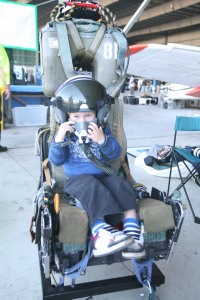




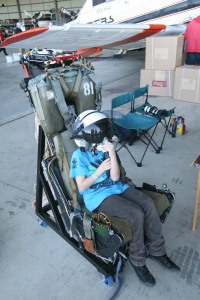
This sitting in an ejection seat may a few years down the track inspire some of the kids to one day consider a career in the RAAF or RAN i hope……..This interest in aviation may lead some of these kids into joining the local Royal Australian Air Force – Air Cadet unit which is co located at the HARS museum. Some of the Air Cadets also tried on a flight helmet and sit in the seat. Some have never had a chance to wear a flight helmet before so were interested in having a go. Other Air Cadets at the Temora airshow last year also took interest in my ejection seat.
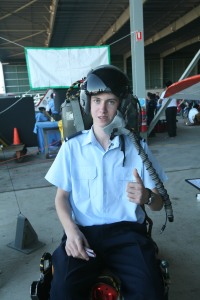


Coming up in the future, we may see more flightgear on show at HARS this year in July 2012, as HARS museum is looking at holding its first ever “Open Cockpit Day” to encourage visitors to come see their collection up close and to sit in some of the cockpits. I have expressed my interest to HARS to allow me to come along to this event to showcase my flightgear display again and educate people. More details will be provided when can.
The growing interest in flightgear has also seen my display encourage the HARS museum to approach me for assistance in helping to create some new flightgear displays to use on some of their static warbird aircraft for future events. I have been asked by some people to assist with making their aircraft displays more authentic with sourcing of appropriate flightgear items. I have in the last few years already helped a few aviation museums and warbird owners in Australia and around the world with such assistance.
Final shot of me wearing some flightgear. The flight suit is a 1960 contract USAF K-2B flight suit in International Orange colour which was designed for high visibility. It was mainly worn by crews in air defence fighters, air rescue, tankers and transports. I wear a L-2B flight jacket with B-17 nose art on back of it and a US Navy drone QF-4 Phantom patch on my cap. I am holding a HGU-55/P flight helmet with MBU-12/P oxygen mask.















